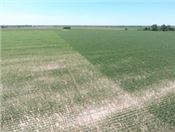Fallow Syndrome Presents In Missouri

This photo from an unmanned aerial vehicle shows the contrast between two Audrain County
cornfields. One field went unplanted in 2015 and the other was planted in soybean.
Corn was planted in both fields this year.
Credit: Photo courtesy of Greg Luce
COLUMBIA, MO.
Cornfields in northeastern Missouri this spring were more uneven following prevented planting acres. Typically, they were phosphorus-deficient and had slower early growth than fields following soybean. These are symptoms associated with corn fallow syndrome, which is known to stunt corn and cause purple, phosphorus-deficient leaves and poorly developed roots.
Its rare occurrence caught producers off-guard, says University of Missouri Extension corn specialist Greg Luce. The syndrome sometimes happens in the year after extremely wet conditions and no crops, or weeds, are grown on the field the previous year. He last remembers it after the 1993 floods.
Fallow syndrome happens when a beneficial fungus, vesicular arbuscular mycorrhizae (VAM), is reduced in the soil. The fungus is associated with the roots of many plants and it benefits corn by helping it take up phosphorus and zinc.
Last year’s unplanted soybean acres were often planted to corn this year as part of a soybean-corn rotation.
Luce says the fallow syndrome was common in Audrain County. Last year, it led Missouri in prevented-planting acres. More than a million Missouri soybean acres went unplanted last year because of the unusually wet conditions through much of May, June and early July of 2015.
In May, farmers in Audrain County and other areas with prevented planting began telling Luce and others that corn was stunted and purple. One corn grower used an unmanned aerial vehicle to photograph adjacent fields. One field appeared normal, the other stunted with a purple cast.
Luce asked about practices and learned that the field with stunted plants went barren of vegetation last year.
Many farmers and farm consultants initially blamed herbicide injury for problem fields. MU Extension weed scientist Kevin Bradley investigated a number of these cases and found no evidence of herbicide injury. Because so little is known about fallow syndrome, Bradley had an analysis conducted on several problem fields and found many of them had reduced levels of microbial populations compared to similar unaffected fields.
Manjula Nathan, director of the MU Soil and Plant Testing Laboratory, published a two-year study in South Dakota that showed a connection between fallow syndrome and low phosphorus.
Luce says little can be done to correct fallow syndrome. To prevent it, he recommends continuing to plant soybeans late into a season. Planting cover crops in early fall helps if soybean cannot be planted. You can apply phosphorus in the spring. Banding on with the planter would be most beneficial. Some 1960s research showed yield improvement by adding phosphorus close to the row and cultivating it in. Rescue attempts are not well-documented. Knifing in additional nitrogen could possibly help also.
Prevention is the best option, Luce says. It is unlikely fallow syndrome will occur two years after the initial fallow period.
Luce recommends the following:
• Plant soybean as late as possible. Soybean has the potential to yield well even late in the season.
• Plant a cover crop. Grasses such as cereal rye, wheat, oats or legumes would be good choices. Turnips and radishes are not hosts to mycorrhizae.
• Consider planting soybean after fallow syndrome. They are not as susceptible to fallow syndrome. ∆